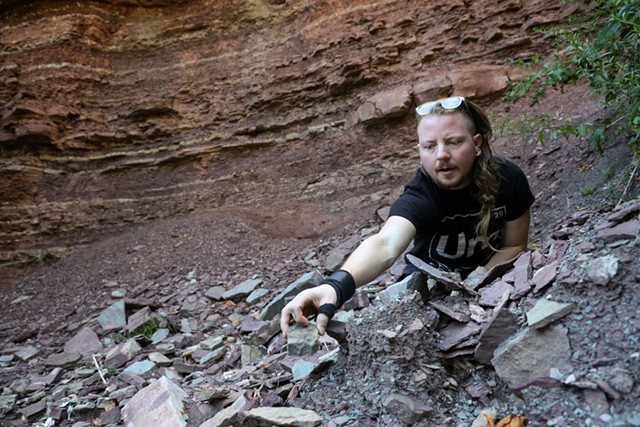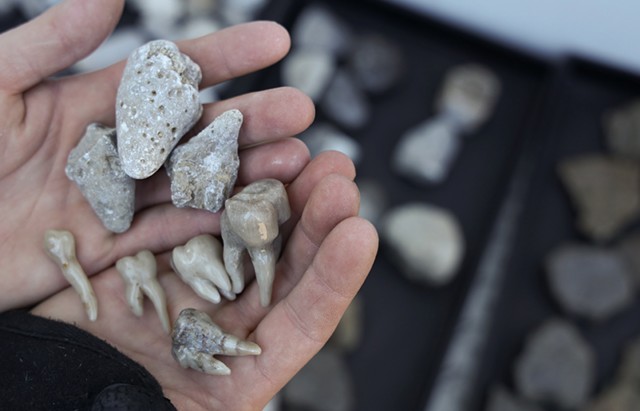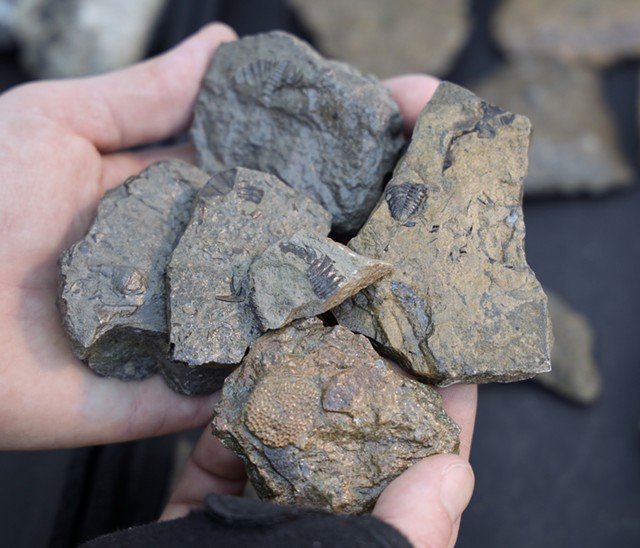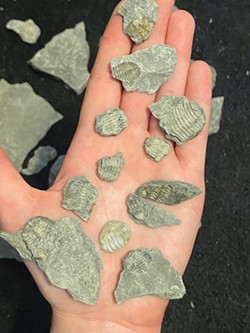[
{
"name": "500x250 Ad",
"insertPoint": "5",
"component": "15667920",
"parentWrapperClass": "",
"requiredCountToDisplay": "1"
}
]
On a breezy summer morning, Khoury Humphrey walked a path along the Genesee River deep in the gorge at Seth Green Park long before the sun reached its peak in the sky. With a few hours to work in the shade, he scanned the base of the exposed limestone and shale gorge wall for treasures to add to his collection of fossilized crinoids, brachiopods, trilobites, horn coral, and other remains of plants and animals that dominated this region hundreds of millions of years ago.
Avoiding areas where the fragile cliff face is crumbling, he scaled some sloping wooded areas and picked over piles of loose stones. He poured water over boulders to highlight the contrast of different minerals, and tapped here and there with a mallet.
Humphrey is a self-taught, amateur rock hound who is adept at identifying the fossils and gems tucked into the terrain of western New York. His collection includes fossils from the Cambrian and Devonian periods, and he makes and sells off-beat jewelry from stones he has carved into shapes like teeth or tiny cinder blocks.
But mostly, Humphrey’s after the pure fascination of the find.
"I’ve noticed that there are a lot of trilobites along a certain bend in the gorge,” Humphrey said. "It really shows you where these things kind of colonized. You can imagine, like, ‘This is the neighborhood of the trilobites,’ and then, ‘This is a neighborhood of the brachiopods,’ and stuff like that. It's a lot of fun to map or envision the ancient underwater life.”
Spend any amount of time outdoors in the company of children, and you’ll quickly realize it’s almost an innate human behavior to pick up a pretty rock and keep it.
People like shiny things, and we like the possibility of stumbling upon something of value or that offers some connection to something deeper. The crystal industry is booming, and according to a 2020 Bloomberg article, worth more than $1 billion globally, supported by people attracted to rare and dazzling beauty.
But you don’t have to drop a lot of dough on rare gems or prehistoric specimens from across the world to own a piece of the earth. The terrain of New York is home to deep geological history, and there’s a wide variety of fossils and minerals readily available, if you know where to find them.
Across the state there are several designated dig spots that are known for yielding gems and fossils. Among the most popular are the Penn Dixie Reserve in Buffalo, the Herkimer Diamond Mine in Herkimer County, and the Hooper Garnet Mine in North Creek in the Adirondacks, where enthusiasts can pay a fee for access to the site that often comes with tools and instructions on digging specific gems or fossils out of the ground.
Another good bet is to search along beaches where fossils may have washed up, or along rivers and creeks where water erosion has does some of the excavation work, revealing strata that span millennia. But treasures can be found just about anywhere, and it pays to keep your eyes open.
“Some lesser fossil-picking spots are parking lots,” Humphrey said.
He recalled stumbling on some of his favorite finds — chunks of honeycomb coral glittering with quartz crystals, and marine animal fossils such as crinoids, which can look like a bird’s footprint — in a Dunkin Donuts parking lot.
“The gravel they use for lots was sourced from some rock quarry somewhere,” he said with a shrug.
Thousands of regional enthusiasts at all skill levels have found camaraderie in common-interest groups on Facebook, including Rock Hounds Upstate New York. That group’s nearly 13,000 members range from people who find something interesting on their own property and want help identifying it, to amateur geologists looking to expand their knowledge about the region’s deep history, and lapidary artists who find, clean up, and sell pretty crystals.
Others are flies on the wall who just want to know where to start. The group is an always-interesting resource for sharing finds, asking advice, and getting connected to other groups and organizations that organize excursions led by more experienced rock hounds.
Jason Dobbs of Rochester is one of the eager-to-help members who knows where to dig in the region and best practices while in the field. He warned novices to be mindful of trespassing on private property, and shared how to avoid running afoul of the law while rock hunting.
“The biggest issue you have to consider is that it's illegal to remove any material from land owned by the state,” Dobbs wrote. “No taking home rocks like fluorescent sodalite from Chimney Bluffs, no cool brachiopod fossils from Second Creek in Sodus.”
While treasures can be found just about anywhere, he said, the safest bets for beginners are the various commercial pay-to-dig sites.
Julia Schwind, a 27-year-old hair stylist based in Fairport, frequents these sorts of sites. Since she began collecting seriously in 2016 she has amassed more than 1,000 crystals and fossils.
Like many people, Schwind’s fascination with rocks began in childhood, and has only sharpened with age.
“It’s a link to the past, a link to things that are unknown that people don't usually think about,” she said. “And I've always thought that was really cool.”
Schwind’s personal collection includes many purchases from collectors across the world who vend their wares at mineral shows and online, but she estimates that about a third of it is self-collected from regional sites. She says she’s always looking, but goes on deliberate digs every week or so.
Among her self-collected favorites are the range of garnets — New York’s state gem — and the 300 or so trilobite specimens she found at Penn Dixie. These Cambrian relics of extinct marine arthropods, easily identifiable by the parallel, horizontal lines of their segmented exoskeletons, are familiar from elementary lessons on regional geological history.
“These fossils are more than 500 million years old,” she said with a child-like wonder. “Some of the very first organisms that showed up on our planet are right here.”
Rebecca Rafferty is CITY's life editor. She can be reached at [email protected].
Latest in Culture
More by Rebecca Rafferty
-

Beyond folklore
Apr 4, 2024 -

Partnership perks: Public Provisions @ Flour City Bread
Feb 24, 2024 -

Raison d’Art
Feb 19, 2024 - More »







